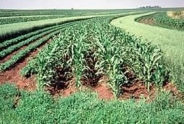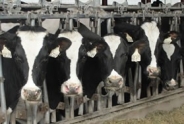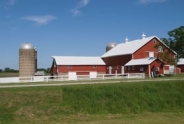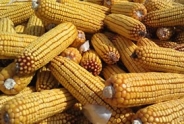Understanding Tar Spot
Katelyn Miller, Field Crops and Forage Specialist
Southwest New York Dairy, Livestock and Field Crops Program
Across New York State, a recently emerged disease poses a threat to the state's corn production. You've likely heard of it, but in case you haven't, this disease is tar spot.
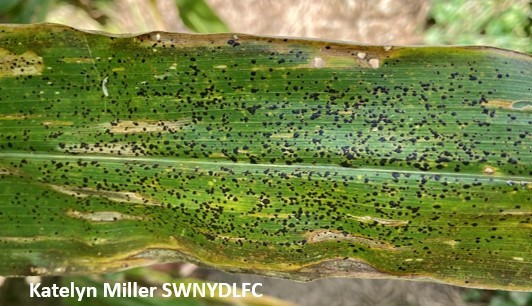
Tar spot is a foliar disease of corn caused by the fungus Phyllachora maydis. The fungus produces small, round to irregular-shaped, raised black structures. These structures are referred to as stromata and present themselves on the upper and lower surfaces of corn leaves. In severe cases, stromata can also be seen on husks, leaf sheaths, and tassels.
This disease originating in Central America, was first reported in the United States in 2015 in some Midwest states. In 2021, the first report of tar spot was identified in New York State. Today, 12 counties in the state have reported this disease with no signs of slowing down.
Phyllachora maydis requires a living host to grow and reproduce. Spores get distributed locally through wind and rain splash but also spread within the field. After infection, new stromata form within a few weeks.
Cool temperatures (60?°F - 70?°F) and high relative humidity favor tar spot development. Extended periods of leaf wetness (at least 7 hours) from rain, fog, irrigation, or high relative humidity will cause disease prevalence to increase.
Yield loss from the onset of tar spot depends on a variety of factors. These include the time of disease onset, weather conditions, and the susceptibility of the planted hybrid. Losses are usually because of reduced ear weight and poor kernel fill in grain corn. Stalk rot and lodging can occur in fields with high severity. Severe infections can hurt corn silage quality by reducing moisture, decreasing digestible components, and reducing energy.
Scouting serves as a valuable tool to determine if tar spot is present. When scouting, lesions can be present anywhere on the plant, depending on when spores were introduced into the field. When scouting, the two biggest questions to ask yourself are:
- Are the lesions showing on both sides of the leaf?
- Does the suspicious spot wipe away with water?
If the answer to either of these questions is no, then it may not be tar spot. These are the most common things that are confused with the disease:
1. Insect Frass and Soil: Frass, more commonly known as insect poop, will rub off the corn leaf as will soil.
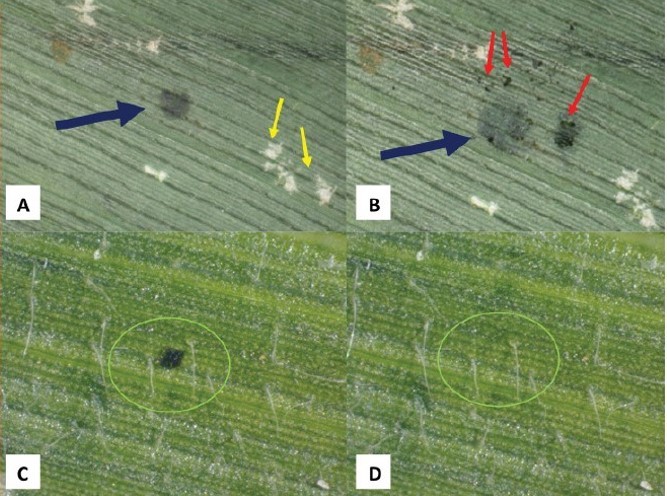
2. Common Rust: As Common Rust lesions mature, they may turn dark brown to black. Use a magnifying glass to evaluate the lesions because they rip through the leaf epidermis. These lesions can be wiped off the leaf surface.
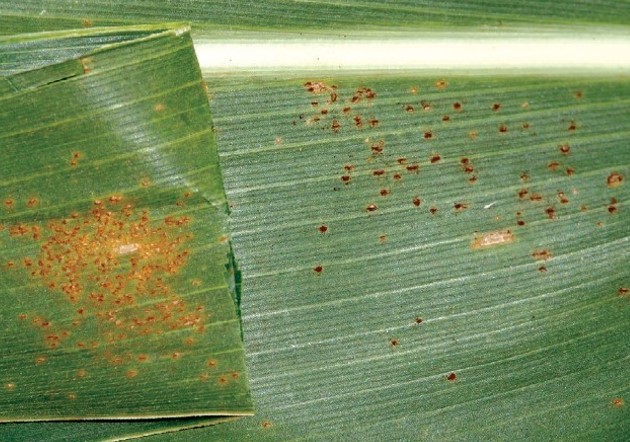
3. Physoderma Brown Spot: Physoderma presents itself as purple or brown circular spots along the leaf midrib and are embedded in the plant tissue. Tar spot often feels bumpy on the leaf surface.
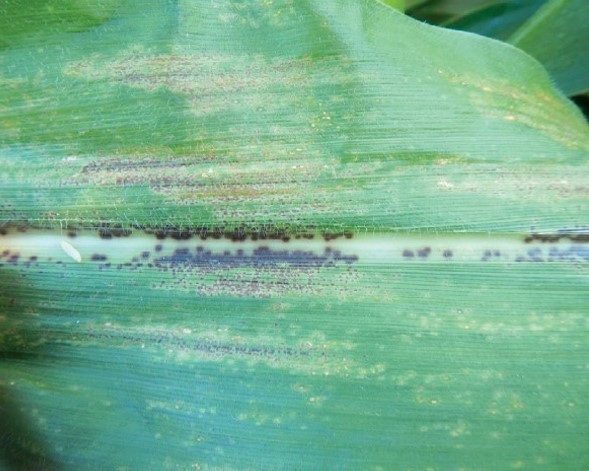
Management of this disease is important to protecting crop yields. Currently, there are no genetics available for tar spot resistant. Regardless, talk with your seed representative and see what options they may have available for reduced susceptibility. The photo below shows two hybrids of the same relative maturity inoculated in adjacent plots with tar spot. The left shows over 40% severity leading to leaf death in the plant. On the right, the hybrid has 25% severity. The difference between these is the susceptibility of the plants, which will be an important component of seed selection.
While selecting varieties with lower susceptibility will be an important management tool, fungicides can also be reliable. The timing of the fungicide application will determine how effective it is. Research shows that fungicide applications have the greatest return on investment when stromata coverage of ear leaves is at 5% or greater at VT-R1. The best management window to spray is VT (tasseling) to R3 (kernel blister). The Tarspotter app has provided some guidance on making applications in areas where tar spot is endemic. This app can be used to help make the decision to spray and optimize the application based on local risk. Use the chart below to identify products currently listed for tar spot in New York State.
* Efficacy rating by university researchers of the Corn Disease Working Group based on replicated field plot experiments in multiple years and locations. F = fair G = good VG = very good
Tar spot is a new disease to New York State, and our understanding of it continues to evolve with ongoing research. If you think you've found tar spot:
- Mark the location in the field.
- Take clear photos.
- Share with crop consultants and CCE specialists to confirm the diagnosis.
If you want to keep up to date on where tar spot has been reported during the season, visit https://corn.ipmpipe.org/tarspot/.
If you're concerned about tar spot on your farm, contact Katelyn Miller at 716-640-2047 or km753@cornell.edu.
Special thanks to the Crop Protection Network, Darcy Telenko, Field Crop Pathology Specialist - Purdue University, and Gary Bergstrom; Professor Emeritus, School of Integrative Plant Science Plant Pathology and Plant-Microbe Biology Section - Cornell University. All photos, unless stated otherwise, are provided courtesy of the Crop Protection Network.
This material is based upon work supported by USDA/NIFA under Award Number 2023-70027-40447.
Upcoming Events
WNY Pastureland Conversion & Soil Health Field Day
July 16, 2025
Middleport, NY
Join American Farmland Trust for the Western New York Soil Health Field Day on July 16, 2025, at Zeliff Farm in Middleport, NY, from 9:00 AM-3:15 PM. Learn about pasture conversion, soil health benchmarking, biochar in grazing systems, and best grazing practices. Plus, enjoy hands-on demos with the NY Soil Health Trailer, drones, and cover crops! Check out the attached agenda for more information about the field day and REGISTER HERE. Zeliff Farms is a regenerative beef operation who has recently partnered with AFT on outreach and education to farmers including learning circles and evaluating biochar effects on soil health.
IPM Strategies to Protect Corn and Soybean Seed in NY
July 30, 2025
Hamburg , NY
SWNYDLFC and Cornell IPM are hosting a grower meeting to discuss integrated pest management strategies for protecting corn and soybean seed in New York.
FAMACHA Training for Sheep and Goat producers in Woodhull NY
August 13, 2025 : FAMACHA Training in Woodhull
Woodhull, NY
Join us for a discussion and hands-on training for internal parasite integrated pest management in sheep and goats. Certification is available to all students participating in the workshop.
Announcements
No announcements at this time.

